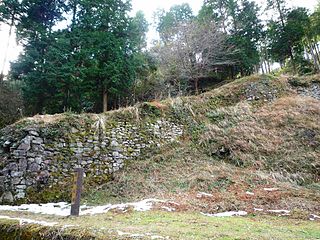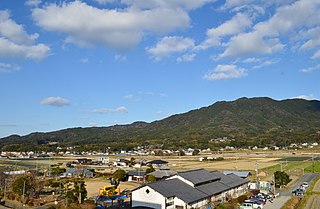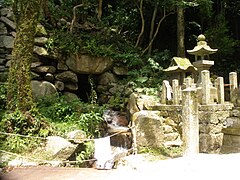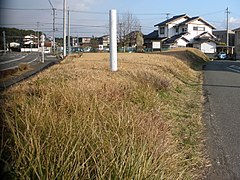
Chikushino is a city in Fukuoka Prefecture, Japan. As of 29 February 2024, the city had an estimated population of 106,513 in 48029 households, and a population density of 1200 persons per km2. The total area of the city is 87.73 km2 (33.87 sq mi).

Kiyama is a town located in Miyaki District, Saga Prefecture, Japan on the island of Kyūshū. As of 31 March 2024, the town had an estimated population of 17,559 in 7508 households, and a population density of 750 persons per km². The total area of the town is 22.15 km2 (8.55 sq mi)

Ki castle was an ancient kōgoishi type castle (also known as a Korean-style fortresses in Japan located in the city of Sōja, Okayama Prefecture, Japan. Its ruins have been protected as a National Historic Site since 1986. Portions of the castle were reconstructed in the early 2000s.

Ōno Castle was an ancient castle (also known as a Korean-style fortresses in Japan straddling the border of the cities of Ōnojō and Dazaifu, and the town of Umi, Fukuoka Prefecture Japan. Its ruins have been protected as a National Historic Site since 1932, and raised to a Special Historic Site since 1953 with the area under protection expanded in 2012. The name of Ōnojō City comes from this castle; however, approximately 80% of the castle area is within the boundaries of Umi Town.

Mizuki Castle was an ancient castle (also known as a Korean-style fortresses in Japan straddling the border of the cities of Ōnojō, Dazaifu, and Kasuga, Fukuoka Prefecture Japan. Its ruins have been protected as a National Historic Site since 1921, and raised to a Special National Historic Site since 1953 with the area under protection expanded in 2013.

Kiyama was an ancient castle (also known as a Korean-style fortresses in Japan located in the city of Sakaide, Kagawa, Japan, and extending partly into the neighboring city of Marugame. Its ruins have been protected as a National Historic Site since 1951. It is also known as Shiroyama Castle or Sanuki-Shiroyama Castle.

Iwakisan Kōgoishi (石城山神籠石) was an ancient castle (also known as a Korean-style fortresses in Japan located in the city of Hikari, Yamaguchi Prefecture, in the San'yō region of Japan. Its ruins have been protected as a National Historic Site since 1951.

Zoyama kōgoshi was an ancient castle (also known as a Korean-style fortress located in the Ōkusa, Setaka-chō neighborhood of the city of Kōge, Chikujō District, Fukuoka Prefecture Japan. Its ruins have been protected as a National Historic Site since 1953, with the area under protection expanded in 1977.

Kōra-san kōgoshi (高良山神籠石) was an ancient castle (also known as a Korean-style fortresses in Japan located in the Mii neighborhood of the city of Kurume, Fukuoka Prefecture Japan. Its ruins have been protected as a National Historic Site since 1953, with the area under protection expanded in 1976 and again in 1989. It is also referred to as the Kōra-san castle ruins, as modern historians tend to discredit earlier theories that similar sites.
Tōbarusan Castle was an ancient castle (also known as a Korean-style fortresses in Japan located in the town of Kōge, Chikujō District, Fukuoka Prefecture Japan. Its ruins have been protected as a National Historic Site since 2005.

Goshogatani Kōgoishi (御所ヶ谷神籠石) was an ancient castle (also known as a Korean-style fortresses in Japan straddling the border between the Katsuyama Okubo townships of Miyako and the Tsuzumi neighborhood of the city of Yukuhashi, Fukuoka Prefecture Japan. Its ruins have been protected as a National Historic Site since 1953, with the area under protetcion expanded in 1998.
Hagi Kōgoishi (杷木神籠石) was an ancient castle (also known as a Korean-style fortresses in Japan located in the Hakihosaka and Hakihayashida neighborhoods of the city of Asakura, Fukuoka Prefecture Japan. Its ruins have been protected as a National Historic Site since 1972.
Ashikisan Castle was an ancient castle (also known as a Korean-style fortresses in Japan located in the Hakiho Ashiki neighborhood of the city of Chikushino, Fukuoka Prefecture Japan. Its ruins have been protected as a National Historic Site since 2011.

Kagenouma Kōgoishi (鹿毛馬神籠石) was an ancient castle (also known as a Korean-style fortresses in Japan located in the Kageuma neighborhood of the city of Iizuka, Fukuoka Prefecture Japan. Its ruins have been protected as a National Historic Site since 1945, with the area under protection expanded in 2002.

Ito Castle was an ancient castle (also known as a Korean-style fortresses in Japan located in the city of Itoshima, Fukuoka Prefecture Japan. Its ruins have been protected as a National Historic Site since 1938, with the area under protection expanded in 1944 and in 2007.

Raizan Kōgoishi (雷山神籠石) was an ancient castle (also known as a Korean-style fortresses in Japan located in the city of Itoshima, Fukuoka Prefecture Japan. Its ruins have been protected as a National Historic Site since 1932.

Obukumayama Kōgoishi (帯隈山神籠石) was an ancient Korean-style fortress located in the Kuboizumimachi neighborhood of Saga, Saga Prefecture, Japan. Its ruins have been protected as a National Historic Site since 1951.

Otsuboyama Kōgoishi (おつぼ山神籠石) was an ancient Korean-style fortress located in the Tachibana neighborhood of the city of Takeo, Saga Prefecture, Japan. Its ruins have been protected as a National Historic Site since 1966.























